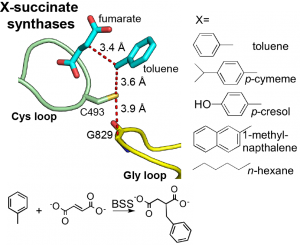Hydrocarbons that compose crude oil are notably inert and contain no functional handles, making their decomposition a challenging task, especially when these hydrocarbons sink deep into soil or marshes where oxygen is limited. X-succinate synthases (XSS), a subclass of glycyl radical enzymes (GREs), provide a biological solution. They use anoxic GRE chemistry to attach unreactive hydrocarbons to fumarate for hydrocarbon degradation. The Drennan lab solved the first structure of an X-succinate synthase, benzylsuccinate synthase (BSS) and we are now pursuing additional structural information to understand substrate specificity. Ideally we would like to identify or design a series of X-succinate synthases that could act on a wide variety of hydrocarbons associated with oil spins.
Press
MIT News October 19, 2015, CEHS News, and LinkedIn, “Using microbes to clean up oil spills,” by Francesca McCaffrey
Publications (*Corresponding authors)
Andorfer, M.C., Levitz, T.S., Liu, J., Chakraborty, A., King-Roberts, D.T., Nweneka, D., Imrich, C.N., and Drennan*, C.L. (2025) Structural basis for anaerobic alkane activation by a multisubunit glycyl radical enzyme, Proc. Natl. Acad. Sci. U.S.A. 122 (32) e2510389122, https://doi.org/10.1073/pnas.2510389122.
Andorfer, M.C., King-Roberts, D.T., Imrich, C.N., Brotheridge, B.G., and Drennan*, C.L. (2023) Development of an in vitro method for activation of X-succinate synthases for fumarate hydroalkylation, iScience 26(6), 106902. doi: 10.1016/j.isci.2023.106902. PMCID: PMC10239695. PMID: 37283811
Funk, M.A., Marsh, E.N.G., and Drennan*, C.L. (2015) Substrate-Bound Structures of Benzylsuccinate Synthase Reveal How Toluene is Activated in Anaerobic Hydrocarbon Degradation, J. Biol. Chem. 11, 22398-22408. PMCID: PMC4566215
Funk, M.A., Judd, E.T., Marsh, E.N.G., Elliott, S.J., and Drennan*, C.L. (2014) Structures of Benzylsuccinate Synthase Elucidate Roles of Accessory Subunits in Glycyl Radical Enzyme Activation and Activity, Proc. Natl. Acad. Sci. U.S.A. 111, 10161-10166. PMCID: PMC4104874
